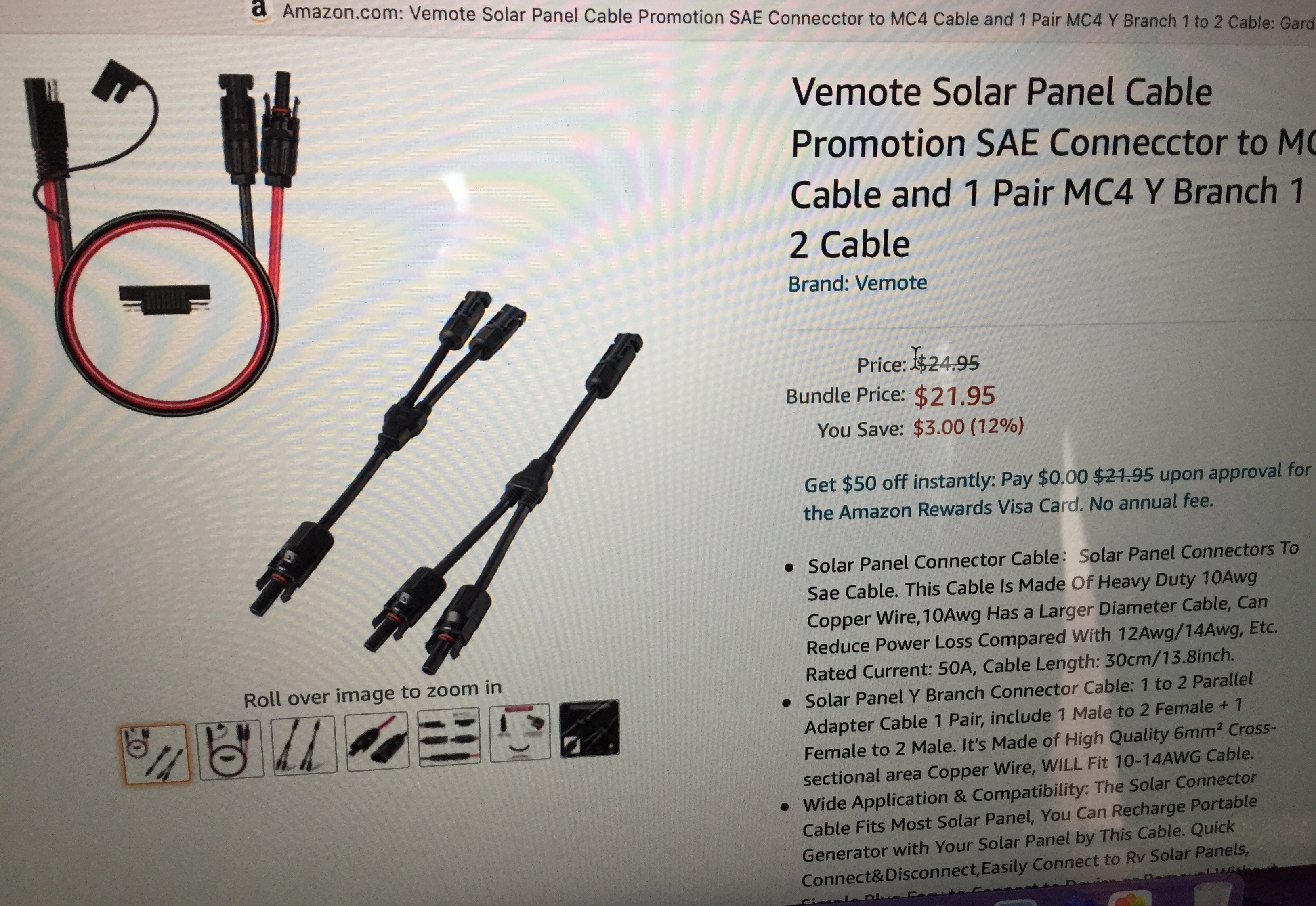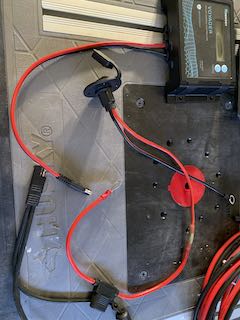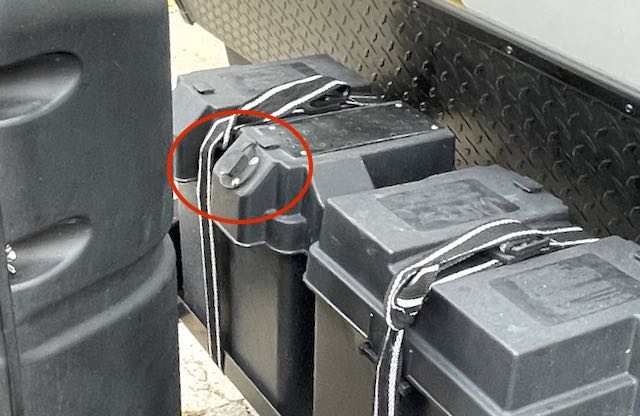solar panels
Printed From: R-pod Owners Forum
Category: R-pod Discussion Forums
Forum Name: I need HELP!!!
Forum Discription: Perplexed/need help with a problem - ask here
URL: http://www.rpod-owners.com/forum_posts.asp?TID=14767
Printed Date: 07 Jun 2025 at 3:41pm
Software Version: Web Wiz Forums 9.64 - http://www.webwizforums.com
Topic: solar panels
Posted By: kansasfrogs
Subject: solar panels
Date Posted: 27 Jun 2021 at 4:38pm
I have the Renogy 100 watt 42x20 solar panel. It came with cable to the controller and to the battery, but how do I get it hooked into the "solar ready" port on the side of the Pod? Do I have to buy more or different cable? Adaptors? I am presuming that once I get it plugged into the port, that it will go through the inverter?converter? already in the camper? First time trying this I found these on amazon. does this look like anything I need? I found these on amazon. does this look like anything I need? ------------- FROGGY |
Replies:
Posted By: Colt
Date Posted: 30 Jun 2021 at 1:07am
|
That *might* be just what you need. The MC4 connectors are common/normal for solar systems so it might be just what connects to your charge controller. The SAE connectors are what Zamp ports use, but check the polarity carefully. Mine is opposite of what I expected. ------------- John '16 R-Pod 180 |
Posted By: kansasfrogs
Date Posted: 30 Jun 2021 at 7:57am
|
Thank you for your response. Have a wonderful summer! Liz ------------- FROGGY |
Posted By: podwerkz
Date Posted: 30 Jun 2021 at 8:00am
|
You still need to install a solar charge controller or provide one externally. ------------- r・pod 171 gone but not forgotten! |
Posted By: offgrid
Date Posted: 30 Jun 2021 at 8:50am
|
The solar ready port is just a connection to the battery. The solar charge controller manages it's own charging, the rpod converter is not involved.
So, you don't need to use that charge port, and many (most?) people don't. It tends to just add more wire resistance losses between your solar module and your battery. You can just connect directly between the solar charge controller and the battery via an inline or bolt on fuse at the battery + terminal. The charge controller can be mounted by the battery or in an adjacent storage compartment if you want. If you do use the existing charge port take heed of the reverse polarity warning and use a voltmeter to be sure you get it right before connecting. It's been deliberately wired reverse to normal for that SAE connector type so that ppl think they have to buy a Zamp solar kit. ------------- 1994 Chinook Concourse 1995 RV6A Experimental Aircraft 2015 Rpod 179 - sold |
Posted By: kansasfrogs
Date Posted: 30 Jun 2021 at 9:22am
|
Thanks for all the info! Liz ------------- FROGGY |
Posted By: StephenH
Date Posted: 01 Jul 2021 at 7:15am
|
The picture you included does show a gender reverser plug in the middle of the coil at the top-left. Use a voltmeter so you know which terminal in your RPod is positive and which is negative (If you touch red lead to one connector and black to another and the reading is positive (e.g. 13.5v), you have the correct polarity. If you get a negative reading (e.g. -13.5v) then the polarity of the plug is opposite of what you connected. Switch the connection of your meter and verify that you get a positive reading with red and black leads. Note which connection is positive. Check the SAE connector on the wire shown above. If the red is going to plug in so red aligns with positive, fine. If not, then use the gender reverser plug to be able to flip the connection around so the red will connect to positive and the black to negative. What I typed sounds complicated, but when you get out there with a meter, it will make sense and be very easy. ------------- StephenH Happy is the man that findeth wisdom,... http://www.rpod-owners.com/forum_posts.asp?TID=7712 - ouR escaPOD mods Former RPod 179 Current Cherokee Grey Wolf 24 JS |
Posted By: kansasfrogs
Date Posted: 01 Jul 2021 at 2:06pm
|
Thanks! I am still learning all this stuff and don't want to ruin a battery or worse! ------------- FROGGY |
Posted By: offgrid
Date Posted: 02 Jul 2021 at 6:12am
|
The advice to always use a voltmeter to confirm is sound. You never know who or when the wiring could have been screwed up by someone. There is a lot of confusion because there are two different wire color standards used for 12v systems in RVs. One is the old automotive standard, red pos, black neg. The other is the national electric code standard which, just like in your house, has black or red hot (in this case positive) and white neutral (in this case negative). You will find the original internal wiring in the trailer following this standard, as the NEC does apply to RVs.
This is all so confusing to some folks that things end up wired wrong on RVs a lot. That often leads to what we call "finding out where they hid the smoke". So, use the voltmeter to confirm what you have, assume nothing, and don't add to confusion for yourself or the next owner by messing up the color code further, use either one or the other standard and stick to it. The other thing folks do a lot is not put in the correct fuses and or circuit breakers when they wire things in their 12v system. 12v battery systems are probably more of a fire safety concern that 120v systems because of the high currents available. But for whatever reason some people who would never dream of bypassing a breaker in their home panel board think they don't need fuses or circuit breakers on their 12v RV circuits. Totally wrong and a Code violation. ------------- 1994 Chinook Concourse 1995 RV6A Experimental Aircraft 2015 Rpod 179 - sold |
Posted By: TEDDY
Date Posted: 07 Jul 2021 at 8:45pm
|
I have 2 100 watt flex solar panels feeding a 30 amp charge controller, with alligator clips from the controller to the 12 v battery. Why do I need an in-line fuse between the charge controller and the battery? ------------- Teddy |
Posted By: offgrid
Date Posted: 08 Jul 2021 at 6:40am
|
Fuses and circuit breakers are there (whether in your house or trailer or anywhere else) to prevent accidental short circuits from causing fires by overheating the wiring.
Batteries produce hundred of amps when shorted. So if you connect your solar charge controller output directly to your battery and then get a short you can easily cause a fire by overheating those wires. It is exactly the same as if you bypassed the breakers in your home panel board and ran a circuit directly to say an outbuilding. Unsafe and a violation of the electric Code. And yes the Code applies to RVs too. Pleas don't do it. ------------- 1994 Chinook Concourse 1995 RV6A Experimental Aircraft 2015 Rpod 179 - sold |
Posted By: kansasfrogs
Date Posted: 08 Jul 2021 at 7:43am
|
Thank you everyone! I will get the fuse and don't plan on using the port. I hooked it up and all seems to be doing o.k. ------------- FROGGY |
Posted By: Colt
Date Posted: 09 Jul 2021 at 11:14am
Something like this from Deltran BatteryTender would be handy for many things battery related. I use one and have a lighter plug adapter so I can use my 12V air compressor.
 ------------- John '16 R-Pod 180 |
Posted By: texastreehugger
Date Posted: 27 Oct 2021 at 8:29pm
|
New Rpod owner here. Our used pod came with a 1000w Jackery power station and 2 solar panels and I'm trying to figure out the best way to use it. We will be making a trip in a few months to a park with no hookups just dump and water fill. I looked for converters from the 8mm plugs to connect to the rv solar port, but then I thought about using the Jackery and my trickle charger to either charge the battery directly or via the port. (And recharging the Jackery with solar). I did notice the polarity was reversed on the port and searched polarity and found this thread. Based on some of the advice here, it look like i should just go straight to the battery. Any thoughts on this set up?
I do understand that the solar may not keep up if we use a lot of the electric. Hoping to run the fridge on propane. I dont have a good read on how long the propane will last. Hopefully it wont get too cold! ------------- 2016 Rpod 182g 2022 Chevrolet Colorado 4x4 |
Posted By: TEDDY
Date Posted: 27 Oct 2021 at 9:17pm
|
The two prong port on the rear of my 2017 rPod goes straight to the battery - there is no charge controller in that line. I use two 100 watt solar panels when no shore power is available in a campground. I run them thru a Renology 30 amp charge controller, connecting the charge controller to the battery directly via aligator clips. You must use a charge controller if you use solar panels to recharge you rPod battery, or you could damage the battery. ------------- Teddy |
Posted By: jato
Date Posted: 27 Oct 2021 at 9:56pm
The fridge will run a long time on propane, the propane hog would be the furnace as you camp in colder weather unless you are at a place that offers electric. Our last 30 day trip we ran the furnace a lot as night temps were always in the 40's or 50's at night in the Rockies during the month of September. We did empty one 20# cylinder but when we left it was probably only half full. This is why we always carry two tanks. And yes, I woke up at 3:45 am at the Great Sand Dunes N.P. and it was about 41 that night, didn't feel much warmer inside as we were both asleep when the tank ran out. ------------- God's pod '11 model 177 '17 Ford F-150 4WD 3.5 Ecoboost Jim and Diane by beautiful Torch Lake "...and you will know the Truth and the Truth will set you free." |
Posted By: Ricktoon
Date Posted: 27 Oct 2021 at 10:58pm
 Here is my connection process from charge controller to battery. My charge controller is at the top right and wired to a short cable with an SAE male connector on the end. I then mounted an SAE female connector (right side) to the battery box with a fuse holder inline on the positive lead. The female connector allows me to plug in the solar without opening the battery box. It is like the solar ready connectors on many older versions of the RPod, I checked to make sure positive and negative are correct with the wiring all the way through. Here is my connection process from charge controller to battery. My charge controller is at the top right and wired to a short cable with an SAE male connector on the end. I then mounted an SAE female connector (right side) to the battery box with a fuse holder inline on the positive lead. The female connector allows me to plug in the solar without opening the battery box. It is like the solar ready connectors on many older versions of the RPod, I checked to make sure positive and negative are correct with the wiring all the way through.
------------- Rick and Ellen B 2019 Chevy Colorado 2021 Rpod 196 |
Posted By: TEDDY
Date Posted: 27 Oct 2021 at 10:59pm
|
Used propane for the fridge camping for 9 days at Shenandoah - used the two solar panels and charge controller to recharge the batteries every day - used interior lights sparingly (battery lanterns work well, even for reading. I also carry a single mantle propane lantern - lots of light and heat. Even used the water pump as Shenandoah Great Meadows has no sites with water. Also used propane for heating water a couple of times. At the end of 9 days I still had about 1/4 of a 20# propane tank left - I only have one tank. This all works fine if you have sun-light. If the weather is bad, you may need to charge your battery with the tow vehicle daily - run for an our or so. ------------- Teddy |
Posted By: Ricktoon
Date Posted: 27 Oct 2021 at 11:09pm
 Here is a view of the SAE connector on the outside of the battery box. Used silicone to ensure a waterproof connection. Small cover protects the plug when not in use. A metail plate added behind connector hold the charge controller which has magnet attached to the back. ------------- Rick and Ellen B 2019 Chevy Colorado 2021 Rpod 196 |
Posted By: texastreehugger
Date Posted: 28 Oct 2021 at 9:15pm
Accidentally double posted  ------------- 2016 Rpod 182g 2022 Chevrolet Colorado 4x4 |
Posted By: texastreehugger
Date Posted: 28 Oct 2021 at 9:21pm
|
Thanks all! Our pod has a single 12v battery configuration and 30 lb propane tank. I took it to a refill station and they confirmed it was nearly full. We will be in Texas so frigid weather should not be too extreme. We will prepare for it just in case. My main question is if I can use the power station and battery tender to recharge the battery (rather than solar panels and charge controller). I realize a trickle charger is really for maintaining a charge, but our Electric use will mainly be lights, charging phone, gps, etc, maybe some tv (kids) which seems like a pretty light use. I've used battery tenders for motorbikes and cars to maintain a charge and I have had success in bringing a slighty depleted battery up to full My battery tender has an inline fuse (simlar to the unit in Colt's post) and I'm thinking it should not damage the battery. ------------- 2016 Rpod 182g 2022 Chevrolet Colorado 4x4 |
Posted By: offgrid
Date Posted: 28 Oct 2021 at 10:40pm
|
What you want to do will work but not well. You will as you point out be limited by the trickle charger output which won't be enough to run much. Also, there is going to be a lot of wasted energy by going from DC current from the Jakery solar modules though the Javkery charge controller, batteries, and it's internal DC to AC inverter, only to get converted back again to DC by the truck charger
Instead, why not run the Javkery solar modules trough a charge controller directly to your trailer battery? should be much more efficient and not limited by the trickle charger. I checrd the Solarsaga 100 module specs and they should work just fine that way. You will need to buy a new charge controller but get a simple PWM type, they're not expensive. ------------- 1994 Chinook Concourse 1995 RV6A Experimental Aircraft 2015 Rpod 179 - sold |
Posted By: texastreehugger
Date Posted: 30 Oct 2021 at 8:56am
|
Thanks, I will look into charge controllers. The losses going through multiple systems makes sense, I just didn't have a feel for how much loss.
------------- 2016 Rpod 182g 2022 Chevrolet Colorado 4x4 |
Posted By: offgrid
Date Posted: 30 Oct 2021 at 10:48am
|
Roughly speaking batteries have a round trip efficiency of about 80%, 12v inverters and AC to DC chargers around 85% percent each, and solar charge controllers around 90-95%. So taking your solar output through the Jackery to the trailer battery is going to have an overall efficiency of around 0.95 * 0.80 * 0.85 * 0.85 = about 55% vs. around 95% if you take the solar output directly to the trailer battery through a charge controller. So it's a pretty big loss. ------------- 1994 Chinook Concourse 1995 RV6A Experimental Aircraft 2015 Rpod 179 - sold |